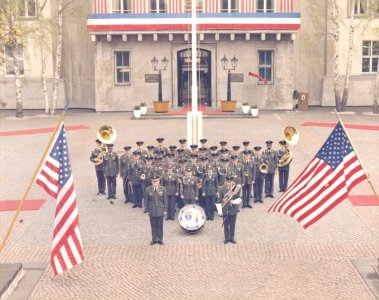A section out of my book:
Terrorism
Terror strikes on U.S. bases and interests in Europe, principally Germany, began in the 1970s and ran until the latter part of the 1980s. These included:
- May 12, 1972. Officers Club near the U.S. Army V Corps Headquarters in Frankfurt bombed by Baader-Meinhof gang, killing one U.S. officer and injuring others (Huffman, Frankfurt V Corps HQ Bombing Damage #1, 2011).Senior Forums
- May 24, 1972. Campbell Barracks, Heidelberg, Headquarters of U.S. Army Europe and 7th Army bombed by Baader-Meinhof gang, specifically in response to bombings in Vietnam, kills three U.S. soldiers (Huffman, May 24, 1972 Heidelberg, October).[ii]
- August 31, 1981. Ramstein Air Base, Rheinland-Pfalz, bombed by Red Army Faction. Twelve U.S. military and two German civilians injured (Editor, 30th anniversary of USAFE headquarters bombing, 2011).[iii]
- August 8, 1985. Rhein-Main Air Base, Frankfurt, bombed by Red Army Faction. One U.S. airman and one U.S. family member killed (Tagliabue, 1985).[iv]
- November 24, 1985. Military Exchange (PX) shopping center in Frankfurt, bombed by persons unknown, however an Iranian and unnamed accomplice were the subject of an international police investigation and charged with the crime. At least 34 persons were injured in the car bomb (Markham, 1985).[v]
Terror attacks occurred elsewhere throughout this time period by differing groups and for different reasons.
On April 5, 1986, at 1:50 A.M., the La Belle Discotheque in the Friedenau subdistrict of West Berlin’s Schöneberg District exploded from a 2kg bomb made of Semtex explosive encasing shrapnel. The blast killed Sergeant Kenneth T. Ford outright, along with a Turkish woman. A second U.S. infantryman, Staff Sergeant James E. Goins, died of his wounds two months later. The disco was known to be frequented by many U.S. servicemen. More than 200 were injured, included 37 (Fleshman, 1986)
[vi] other U.S. military, all of whom were awarded the Purple Heart for sustaining wounds at the hands of terrorists.
The attack on the LaBelle was seen as revenge for the sinking of Libyan patrol boats and destruction of a Libyan missile control site by U.S. warplanes in March 1986 when those planes were attacked by up to six Libyan surface to air missiles (Gerstenzang, 1986).
[vii] U.S. intelligence indicated Libya’s involvement in the LaBelle bombing, so President Ronald Reagan ordered retaliatory strikes on the leadership and government of Muammar Khadafi 10 days after the disco bombing (Connolly, 2001).
[viii] F-111 bombers and other aircraft flew out of their bases in England and hammered targets in Tripoli and Benghazi.
CW3 David M. Smith, commander of the 298th at the time of the LaBelle disco attack, recalls receiving a phone call at his quarters at about 0230 – a scant 45 minutes after the bomb’s detonation. He was instructed by the Berlin command’s Emergency Operations Center (EOC) to initiate a unit recall/alert. Mr. Smith was informed that there had been an “incident” downtown with mass casualties and that a solid headcount was needed to determine personnel accountability.
Mr. Smith immediately phoned the 298th’s Charge of Quarters and instructed him to execute the band’s alert roster/phone tree. Mr. Smith added the instruction that this was no drill.
At about 0315 hours, the band was fully assembled or accounted for. Mr. Smith submitted the appropriate report to the EOC. The band was then instructed to stand fast and await further instructions. Later that morning, the band stood down and went about the normal duty day.
Mr. Smith further recalls planning and conducting two Battalion Funeral Parades per Army regulations and field manuals, commensurate with the death of each soldier. Noteworthy about these parades was the parade to the McNair Barracks chapel was conducted with the respective battalion commander and his staff leading the formation, with no guidon (unit flag). The band’s drums were draped in black and the snares on those drums were turned off. Mr. Smith had directed to play a Beethoven dirge on the way to the chapel.
From the chapel following the service, Army procedure stated to undrape the drums and turn the snares on. Mr. Smith ordered uplifting patriotic music to be played, characterized by the band’s performance of Sousa’s Washington Post march.
After the fall of the Berlin Wall in 1989 and the opening of secret files of the East German Staatsicherheitamt (Stasi), evidence indicated direct Libyan government involvement with an intercepted radio transmission to the Libyan embassy in East Berlin with orders to attack “with as many victims as possible.” Telegrams supported the charge of Libyan involvement.
[ix]
Senior Forums Frankfurt V Corps HQ Bombing Damage #1 - baader-meinhof.com
[ii] Tag Archive for "Campbell Barracks" - baader-meinhof.com
[iii] http://www.stripes.com/30th-anniversary-of-usafe-headquarters-bombing-1.153700
[iv] http://www.nytimes.com/1985/08/09/world/car-bomb-kills-2-on-a-us-air-base-in-west-germany.html
[v] http://www.nytimes.com/1985/11/25/world/bombing-at-px-in-frankfurt-wounds-34.html
[vi] http://www.theberlinobserver.com/archive/1986V42/V42_N21_may_30.pdf
[vii] http://articles.latimes.com/1986-03-25/news/mn-2_1_patrol-boat
[viii] http://www.theguardian.com/world/2001/nov/14/kateconnolly
[ix] Ibid
Photo taken in 1985; U.S. Army, Berlin Brigade



